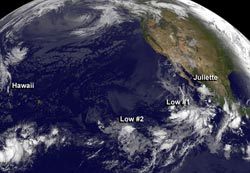Satellite Panorama of Fizzling Juliette and Two Lows in Eastern Pacific

On Aug. 30, NOAA's GOES-West satellite captured the fizzling post-tropical cyclone Juliette near the Mexican coast, and two other low pressure areas that are struggling to develop. <br><br>Image Credit: NASA GOES Project<br>
NOAA's GOES-West satellite sits in a fixed orbit that covers the western U.S. and the Pacific Ocean, providing imagery on a continual basis. NASA's GOES Project at the NASA Goddard Space Flight Center in Greenbelt, Md. created a panoramic image of the Pacific that showed the weakening post-tropical cyclone Juliette and two low pressure areas on Aug. 30 at 1200 UTC/8 a.m. EDT.
The National Hurricane Center issued their final warning on post-tropical cyclone Juliette on Aug. 30 at 0300 UTC/Aug. 29 at 11 p.m. EDT. At that time, Juliette was located near 26.7 north and 114.8 west, about 80 miles south-southeast of Punta Eugenia, Mexico. Juliette was moving to the northwest at 12 knots. Its maximum sustained winds were down to 25 knots. Although Juliette no longer qualifies as a tropical cyclone, its remnants will be producing showers over Baja California today.
One of the two developing low pressure areas in the Eastern Pacific sits about 525 miles southwest of the southern tip of Baja California. The low is disorganized by has some showers associated with it. It is moving north at 10 to 15 mph toward cooler waters, which is expected to inhibit any development. The low has just a 20 percent chance of becoming a tropical depression today and over the next five days, according to the National Hurricane Center.
The second low pressure area isn't faring any better in the development category. This low is located 1,000 miles away from the first area. It is centered about 1,550 miles west-southwest of the southern tip of Baja California and is moving northeastward. This low has a 10 percent chance of development into a tropical depression in the next two days.
Text credit: Rob Gutro
NASA's Goddard Space Flight Center
Media Contact
All latest news from the category: Earth Sciences
Earth Sciences (also referred to as Geosciences), which deals with basic issues surrounding our planet, plays a vital role in the area of energy and raw materials supply.
Earth Sciences comprises subjects such as geology, geography, geological informatics, paleontology, mineralogy, petrography, crystallography, geophysics, geodesy, glaciology, cartography, photogrammetry, meteorology and seismology, early-warning systems, earthquake research and polar research.
Newest articles

Properties of new materials for microchips
… can now be measured well. Reseachers of Delft University of Technology demonstrated measuring performance properties of ultrathin silicon membranes. Making ever smaller and more powerful chips requires new ultrathin…

Floating solar’s potential
… to support sustainable development by addressing climate, water, and energy goals holistically. A new study published this week in Nature Energy raises the potential for floating solar photovoltaics (FPV)…

Skyrmions move at record speeds
… a step towards the computing of the future. An international research team led by scientists from the CNRS1 has discovered that the magnetic nanobubbles2 known as skyrmions can be…




















